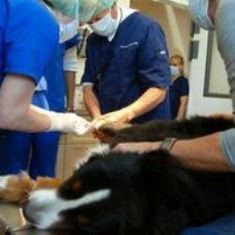 March 2018 – Traumatic Brain Injury and our pets
March 2018 – Traumatic Brain Injury and our pets
Just like humans, our pets can sustain trauma to the head resulting in traumatic brain injury (TBI). Head trauma is a medical emergency and can have far reaching health effects, so much so that March has been deemed Brain Injury Awareness Month by the Brain Injury Association of America.
How does a pet suffer a TBI?
Our pets can suffer injuries to the brain when they are hit by a car, attacked and bitten around the head by a larger animal, shaken by a larger animal, or when they fall a distance to the ground. A gunshot wound or blunt force trauma of some sort can also cause a TBI. Cats may suffer a TBI as a result of severe hyperthermia or hypothermia and prolonged seizures.

The bony skull and the large amount of muscle mass that is normally present in dogs and cats provide some protection for the brain, but certainly injuries do result. The brain is a vital organ and requires a constant supply of oxygen and nutrition. Any deficiency of oxygen or direct trauma to the brain therefore may result in bleeding and fluid buildup, which can cause excessive pressure on the brain. This in turn can cause complications involving the heart, eye, and several other body systems. Symptoms vary and depend on the cause and severity of the brain injury. Some of the more common symptoms include:
- Seizures
- Loss of consciousness
- Abnormal posture or irregular movements
- Ear or nose bleed
- Bleeding inside the eye (involving the retina)
- Bluish discoloration of the skin and mucous membranes (cyanosis); a sign that oxygen in the blood is dangerously diminished
- Insufficient oxygen reaching body tissues
- Purplish or bluish patch under the mucous membranes) or under the skin due to ruptured blood vessels
- Red or purple spot on the body caused by a minor hemorrhage
- Heavy or rapid breathing
A TBI is a medical emergency
If your pet suffers a trauma to the head, consider this a medical emergency and make sure your pet is seen by a veterinarian immediately for the best possible outcome. Treatment of a brain injury will depend on what led to the brain injury. Your pet’s breathing and cardiovascular function will be evaluated and intravenous fluids (IV) will be administered to treat shock and stabilize blood pressure. Oxygen supplementation is often provided for the first few hours after a head injury.

Once breathing and blood pressure are stable, the veterinarian will perform a careful neurological examination to assess for signs of TBI. Symptoms of TBI may include loss of consciousness, seizures, weakness in the legs or pinpoint pupils. If symptoms of TBI are identified, the veterinarian will usually administer medication to help control swelling of the brain and decrease intracranial pressure. When fractures involving the skull are suspected, X-rays, CT (computed tomography) scans, and MRIs (magnetic resonance imaging) are extremely useful to evaluate the severity of the brain trauma. These diagnostic tools also help in determining the presence of bleeding, fractures, foreign bodies, tumor, and other abnormalities involving brain. The ECG (electrocardiogram), meanwhile, is used to evaluate heart functions and rhythm.
Expect admission to the animal hospital for close monitoring and intensive care. In patients with severe or worsening neurological symptoms, referral to a neurologist and further treatment will be recommended. Some patients require surgery, and the veterinarian may collect cerebrospinal fluid sample to determine the level of inflammation and to confirm possible infections.
Pets that are young and those with less severe injuries have a better chance to make a full recovery. Unfortunately, those with the most severe injuries or rapidly worsening neurological signs may not survive their trauma despite treatment. Medications may be administered to treat infections or to address pain, nausea or seizures.

Recovery
Once it is determined that the pet is in the recovery stage and is released back home, he/she should be placed in a stress-free environment, away from other pets and active children. In addition, his/her activities should be restricted until the veterinarian advises otherwise. Sometimes tube feeding may be necessary for the first few weeks for nutritional support.
It is important you watch your pet for any unusual behaviors, bleeding, or vomiting and inform the veterinarian immediately if any of these symptoms occur. Regular follow-up exams with your veterinarian will be necessary to evaluate the neurologic functions of the pet. Frequent laboratory testing may also be required to monitor the pet’s overall health.
Some patients can have long-term neurological signs, such as seizures, that require ongoing treatment. In patients with more severe injuries who are significantly older or who have multiple pre-existing medical problems, recovery is less certain. Each case will be unique. Follow your veterinarian’s recommendations for the best result.
Recommended Reading:
Learn Pet First Aid and CPR – You just might save a life!
Belle Mead Animal Hospital, Your Other Family Doctors
Handling Every Pet with Love Every Day!
LIKE us on Facebook and Follow us on Twitter @BMAH121, Pinterest and Google+ for news and pet wellness tips. We’re also on YouTube! Subscribe for updates!









